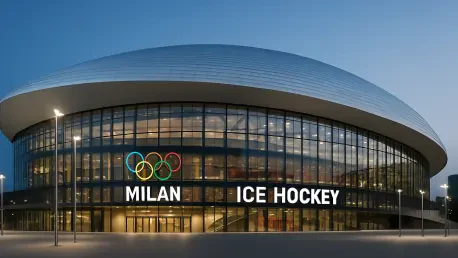As the 2026 Winter Olympics in Milan, Italy, draw near, a cloud of uncertainty hangs over the construction of the primary ice hockey venue, PalaItalia Santa Giulia, raising serious concerns with less than a year to go. With the games approaching fast, the National Hockey League (NHL) has voiced significant worries about whether this critical facility will be ready to host world-class competition. The stakes are high, as this marks the return of NHL players to the Olympic stage for the first time since 2014, following a significant hiatus. The league’s apprehension centers on tight timelines and delayed test events, prompting a proactive response to ensure standards are met. This situation not only highlights logistical challenges but also underscores the NHL’s commitment to delivering an exceptional experience for players and fans alike. As the countdown continues, the focus remains on whether Milan can overcome these hurdles to provide a fitting arena for one of the Olympics’ most anticipated events.
Venue Construction Challenges
Progress Delays at PalaItalia Santa Giulia
The construction of PalaItalia Santa Giulia, designed to accommodate 16,000 spectators for the 2026 Winter Olympics, has encountered significant setbacks that have alarmed NHL officials. Initially slated for a test event in December, the timeline has been pushed to January, leaving a narrow window before the women’s hockey tournament begins on February 5, followed by the men’s on February 11. This delay raises questions about the venue’s readiness to host high-stakes international matches. NHL Commissioner Gary Bettman has consistently highlighted the tight schedule over recent months, emphasizing the need for a fully functional facility. The pressure is mounting as the league seeks assurance that the infrastructure will meet the rigorous demands of professional athletes. Beyond mere completion, the quality of the ice surface, locker rooms, and spectator amenities must align with global standards to ensure a seamless event. With time slipping away, the upcoming inspection by NHL representatives Derek King and Dean Matsuzaki next week is critical to gauging progress.
Logistical Impacts and Alternative Plans
Beyond the immediate delays, the ripple effects of construction challenges at PalaItalia Santa Giulia could impact the broader Olympic hockey schedule. The NHL, while not directly responsible for venue preparation, is keenly aware of the need for contingency plans should the main arena fall short of expectations. Discussions within the league, as voiced by Deputy Commissioner Bill Daly, reflect a cautious approach, with hopes pinned on clarity following the site visit. A smaller venue, Fiera Milano, with a capacity of 6,500, is also part of the Olympic setup, but it cannot fully substitute for the primary rink’s scale and purpose. The logistical strain of potential last-minute adjustments looms large, especially given the compressed timeline. Ensuring player safety and competitive fairness remains paramount, as any compromise could tarnish the event’s reputation. The NHL’s vigilance in monitoring these developments underscores the complexity of coordinating such a high-profile international competition under constrained circumstances.
NHL’s Stance and Expectations
Commitment to Olympic Participation
The NHL’s renewed commitment to the Winter Olympics, solidified by a February 2024 agreement with the Players’ Association and the International Ice Hockey Federation for the 2026 and 2030 Games, reflects a significant shift after missing the 2018 and 2022 events due to various challenges. This decision underscores the league’s desire to showcase its talent on a global stage, particularly after a long absence since the 2014 Sochi Games. The historical success of teams like Canada, with gold medals in past NHL-participated tournaments, adds to the anticipation surrounding the upcoming competition. However, this enthusiasm is tempered by the looming uncertainty over venue readiness in Milan. The league’s proactive step of dispatching representatives for an on-site evaluation demonstrates a balance of optimism and pragmatism. Ensuring that the facilities match the caliber of the athletes competing is non-negotiable, as the NHL aims to uphold the integrity of the sport while re-establishing its Olympic presence.
High Standards and Oversight Efforts
Maintaining a world-class competitive environment is at the core of the NHL’s expectations for the 2026 Winter Olympics, and the league is leaving no stone unturned in its oversight of Milan’s preparations. While the International Olympic Committee (IOC) holds primary responsibility for the facilities, the NHL, as an invited guest, insists on rigorous standards for PalaItalia Santa Giulia. Commissioner Bettman’s long-standing concerns about the timeline are echoed by other league officials who stress the importance of flawless execution. The diversity of perspectives within the NHL—from cautious hope to firm demands—illustrates a unified goal of safeguarding the event’s quality. The upcoming inspection is not merely a formality but a pivotal moment to assess whether the IOC can deliver on its promises. Should issues persist, the league’s influence could push for accelerated efforts or alternative solutions. This meticulous attention to detail highlights the NHL’s dedication to ensuring that the return of its players to the Olympic stage is nothing short of exceptional.
Reflections on a Critical Moment
Looking back, the journey toward the 2026 Winter Olympics in Milan revealed a complex interplay of ambition and uncertainty surrounding the hockey venues. The NHL’s deep investment in the event, driven by a storied history of Olympic participation and a recent recommitment to the global stage, stood in stark contrast to the logistical hurdles faced at PalaItalia Santa Giulia. Construction delays and postponed test events became focal points of concern, prompting decisive action from league officials through on-site evaluations. Moving forward, the insights gained from the inspection carried out by NHL representatives offered a crucial opportunity to address any shortcomings. Collaboration between the NHL and the IOC could pave the way for innovative solutions, whether through accelerated construction timelines or enhanced contingency planning. As the games approached, maintaining open communication and a shared commitment to excellence emerged as vital steps to ensure that Milan delivered an unforgettable stage for Olympic hockey.









